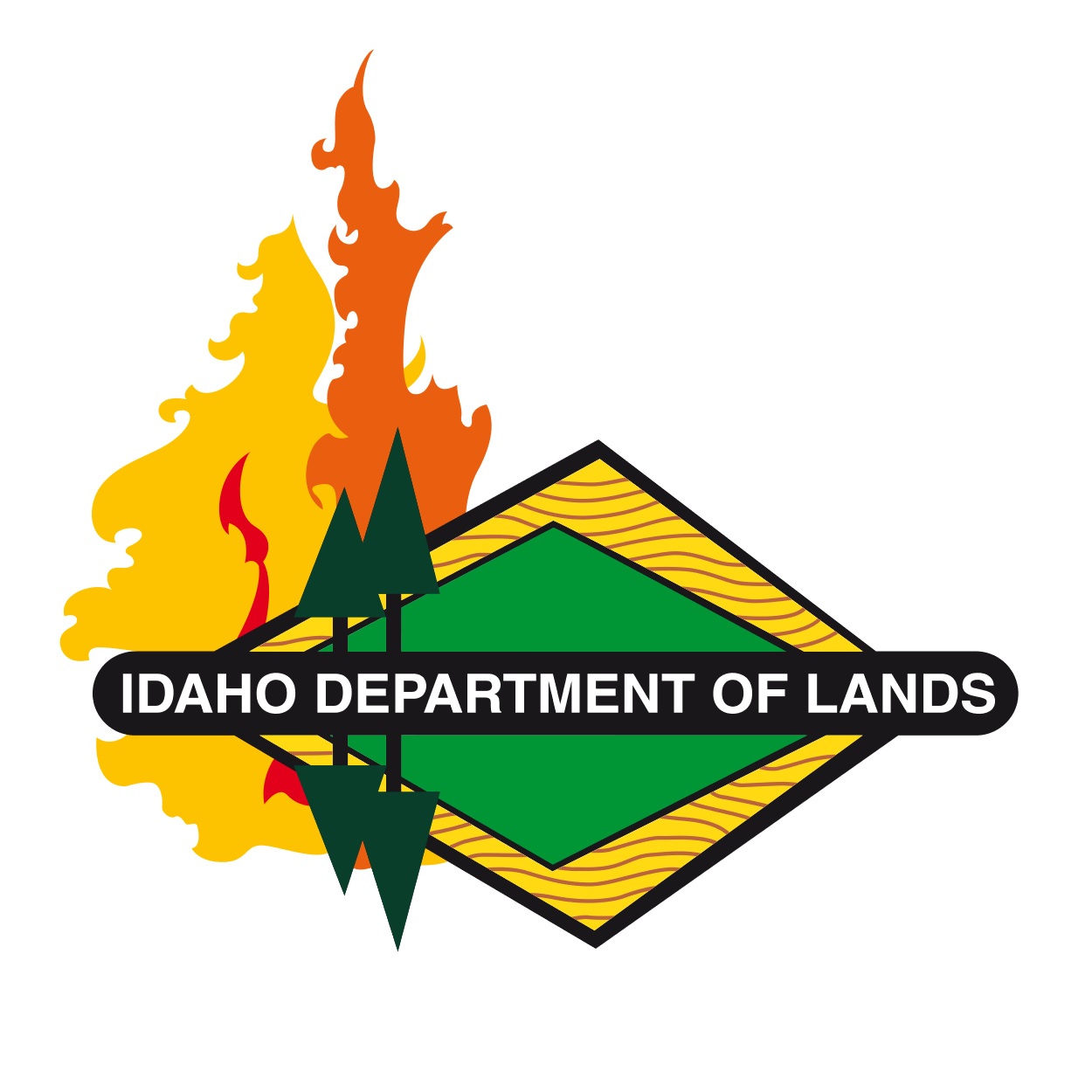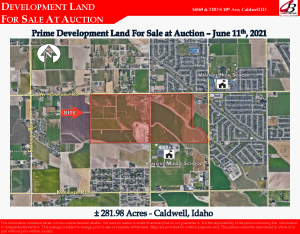Category: All News Releases
Unique endowment land auction brings in a sale price of $35.2 million
(Boise) – Two adjacent agriculture college endowment parcels amounting to 282 acres adjacent to Caldwell’s Vallivue High School and Middle School sold today for $35.2 million, plus a buyer’s premium of $1,408,000 with a total cost to the buyer of $36,608,000.
The parcels are in one of the fastest-growing counties in Idaho and were expected to bring in competitive bids above the minimum appraised value of roughly $6 million. There were 12 bidders. The winning bidder was Endurance Holdings, LLC who bought both parcels, which are designated for low-density residential use in the City of Caldwell’s Future Land Use Map.
A broadcast-quality video of the final moments of the auction is available for viewing/download at: https://www.dropbox.com/s/ndcjx4r1sfyquwn/Video%20Jun%2011%2C%201%2043%2005%20PM.mov?dl=0.
Reason for the auction: The University of Idaho has leased the parcels for agricultural research purposes since the 1940s, but the University recently sold the training facility adjacent to the land. The preference was to reinvest in land that will facilitate a new Center for Agriculture, Food and the Environment (CAFE) located in the Magic Valley. The State Board of Land Commissioners agreed to the auction after determining that it would bring the highest net sales proceeds to the beneficiary. At statehood, Idaho was granted endowment land for the sole purpose of financially supporting specific institutions.
“This auction was incredibly valuable because the land was no longer supporting the University’s research facility and the revenue generated from the farm lease on the land was nominal,” said Josh Purkiss, Idaho Department of Lands Real Estate Services Bureau Chief. “It was the right time to sell this land in the best interest of the endowment beneficiaries.”
Bidders had to deposit $250,000 per parcel in cashier checks to qualify to bid at the auction. It was held Friday, June 11 at 12:30 p.m. at the Marriot Courtyard, located at 1789 South Eagle Road in Meridian, Idaho. Corbett Bottles Real Estate Marketing facilitated the auction.
###
Media contact
Robbie Johnson – Idaho Department of Lands Public Information Officer
208-334-0236/ 208-908-1786
rjohnson@idl.idaho.gov
Unique land auction in Caldwell could generate at least $6 million
(Boise) – Two side-by-side endowment land agriculture parcels amounting to 282 acres sit mostly unused adjacent to Caldwell’s Vallivue High School and Middle School. The parcels are in the direct path of growth in one of the fastest-growing counties in Idaho.
Endowment lands are unique: At statehood, Idaho was granted endowment land for the sole purpose of financially supporting specific institutions. The parcels up for auction were designated to benefit the University of Idaho and are managed by the Idaho Department of Lands.
Reason for the auction: The University of Idaho has leased the parcels for agricultural purposes since the 1940s, but the University would rather have the property auctioned for residential development to generate greater revenue. The State Board of Land Commissioners agreed to the auction after determining that it would bring the highest financial return to the beneficiary.
“This proposal makes sense because right now the land is no longer supporting the University’s research facility and the revenue generated from the farm lease is nominal,” said Josh Purkiss, Idaho Department of Lands Real Estate Services Bureau Chief. “With the current high demand for land, and the prime development nature of these parcels, this has the potential to be a very exciting auction for the endowment beneficiaries.”
Auction details: Both parcels are designated for low-density residential use in the City of Caldwell’s Future Land Use Map. Bidders must have $250,000 per parcel in cashier checks to qualify to bid at the auction. It will be held Friday, June 11, 2021 at 12:30 p.m. at the Marriot Courtyard, located at 1789 South Eagle Road in Meridian, Idaho. Details can be found at Corbett Bottles Real Estate Marketing.
###
Media contact
Robbie Johnson – Idaho Department of Lands Public Information Officer
208-334-0236/ 208-908-1786
rjohnson@idl.idaho.gov
Idaho’s State Forester to speak before Congressional Committee on Natural Resources
(Boise) – Idaho’s State Forester Craig Foss will discuss the relationship between drought, wildfires and forest health before a House Committee on Natural Resources subcommittee on Tuesday, May 25, 2021 in Washington D.C. Representative Russ Fulcher (R-ID) invited Foss to speak before the Western Drought Forum titled, “The status of drought conditions throughout the western United States.”
Idaho’s national forests comprise 80% of the state’s total forestland. Of federal forestland suitable for management, more than 8 million acres are in declining condition, leaving them at high risk of insect and disease and wildfire mortality.
As State Forester with the Idaho Department of Lands, Foss oversees the forestry and fire programs for the state of Idaho. Foss will share about Idaho’s efforts and goals through Shared Stewardship and Good Neighbor Authority agreements to double the number of acres treated and restored on our most at-risk federal forestlands. Adjacent state, industrial and family forestland will also be treated, assuring landscape-scale forest health improvements.
“Managed forests are healthy forests, better able to withstand wildfire, pests, and drought, and more capable of storing carbon, providing clean air, water, wildlife habitat, economic and recreational opportunities, and countless other benefits,” Foss said. “Forests, water and people are dependent on one another.”
Foss says it will take many years to address the extensive work needed to restore forested watersheds in Idaho and throughout the west. Foss will stress the need for consistent national policy support.
“It will require increased funding for climate change research, active forest management, wildfire mitigation, increased use of prescribed fire and reforestation,” said Foss.
The subcommittee meeting will be held Tuesday, May 25, 2021 at 11 a.m. MST. (1 pm EST) and can be seen at https://naturalresources.house.gov/hearings/remote-wow-oversight-hearing_may-25-2021/.
# # #
Media Contact: Sharla Arledge | PIO | 208-334-0286 | pio@idl.idaho.gov
Beware: Burn piles from the fall may go into flames
(Coeur d’Alene) – Every fall, many forest landowners gather up branches/slash from logging activities and burn large piles. However, some make the mistake of assuming that the fire is completely out, when in fact the remaining unburned material may smolder for months under winter snow.
It is extremely important to be sure your pile is out: Go back and check the piles for heat. The pile must be cold to the touch. Large piles of unburned material may need to be moved around to ensure the fire is completely out. Remember, people may be liable for the cost of fire suppression if their fire gets out of control.
Already this year there have been reports of those still-smoldering piles catching flame. That, combined with unusually dry conditions for this time of year, is creating a serious wildfire risk with fires already occurring as a result.
More about at-risk piles: Large piles of tree materials that were pushed together by bulldozers or other types of equipment are especially at risk of smoldering and catching flame because the dirt and rocks may cover partially-burned tree material, allowing it to smolder without visible evidence. Snow cover can further insulate the pile, creating a slow-cook heat within the pile. Once the snow melts and the material dries out, the smoldering heat can catch flame and spread to other areas. The attached photos from this spring near Bonners Ferry in North Idaho are examples.
If you are doing any burning: Burn permits are required May 10 – October 20 each year. They are free. They are not required for campfires.
Who needs a permit: Idaho law (38-115) requires any person planning to burn outside city limits within Idaho, including crop residue burning, to obtain a state burn permit during this period, referred to as closed fire season. A burn permit must be obtained before starting debris burning activities and you must have it with you when burning. Other laws related to open burning in Idaho also apply. Permits are free and good for 10 days. Campfires do not require a burn permit.
How to get a burn permit: Visit the self-service website burnpermits.idaho.gov. Permits are available seven days a week and are immediately issued and valid. No matter where you want to burn and what you plan to burn, the system will either issue you the burn permit you need on the spot or tell you which entity to contact for alternate or additional permits. A permit may also be issued by your local IDL office.
About IDL Fire: Idaho Department of Lands Fire Management (IDL Fire) in partnership with two Timber Protection Associations and with the support of rural volunteer fire departments and other partners, are responsible for fire suppression and prevention on more than 6 million acres of state and private forests and rangelands in Idaho. IDL Fire focuses on initial attack with the goal of keeping fires at 10 acres or less. IDL Fire protects and preserves important endowment timber assets that help fund Idaho schools and other beneficiaries, as well as millions of acres of private forestland.
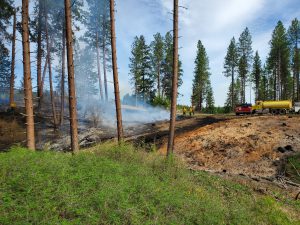
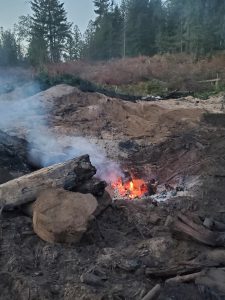
Media Contact
Robbie Johnson
Idaho Department of Lands
Public Information Officer
pio@idl.idaho.gov
208 908-1786
State Burn Permits required May 10 – October 20
(BOISE) – The number of burn permits issued averages about 18,000 a year in Idaho, and that number continues to rise. Burn permits are required May 10 – October 20 each year and issued by the Idaho Department of Lands (IDL).
Who needs a permit: Idaho law (38-115) requires any person planning to burn outside city limits within Idaho, including crop residue burning, to obtain a state burn permit during this period, referred to as closed fire season. A burn permit must be obtained before starting debris burning activities and you must have it with you when burning. Other laws related to open burning in Idaho also apply. Permits are free and good for 10 days. Campfires do not require a burn permit.
How to get a burn permit: Visit the self-service website burnpermits.idaho.gov. Permits are available seven days a week and are immediately issued and valid. No matter where you want to burn and what you plan to burn, the system will either issue you the burn permit you need on the spot or tell you which entity to contact for alternate or additional permits. A permit may also be issued by your local IDL office.
Why permits are important: Obtaining the burn permit lets fire managers know where permitted burning is occurring so they can respond more quickly to a controlled burn if it escapes, potentially reducing the liability of the burner. You will also help prevent false runs to fires, saving firefighting resources for instances where they are truly needed.
Other resources: Using burnpermits.idaho.gov also connects you to tips for safe burning practices and informs you of current fire restrictions in place statewide. Information on burn restrictions based on air quality can be found by calling Idaho Department of Environmental Quality at (800) 633-6247 or by visiting http://www2.deq.idaho.gov/air/AQIPublic/Map/OutdoorBurn.
About IDL Fire: Idaho Department of Lands Fire Management (IDL Fire) in partnership with two Timber Protection Associations and with the support of rural volunteer fire departments and other partners, are responsible for fire suppression and prevention on more than 6 million acres of state and private forests and rangelands in Idaho. IDL Fire focuses on initial attack with the goal of keeping fires at 10 acres or less. IDL Fire protects and preserves important endowment timber assets that help fund Idaho schools and other beneficiaries, as well as millions of acres of private forestland.
Juliaetta Fire contained
(Juliaetta, Idaho) The Juliaetta Fire is contained after no additional fire growth occurred overnight. Containment means that a control line has been completed around the fire which can be expected to stop the fire’s spread if conditions remain the same. The fire size was 20 acres and this will be the last update unless significant activity occurs.
Pictures from Thursday, April 22 of the Juliaetta Fire are below. The photo showing the moss burning on the rocky hillside is an indication of how dry conditions are for this time of year.
Idaho Department of Lands Forest Protection District Wardens remind the public to please:
- Check the weather forecast prior to burning
- Have a source of water available
- Monitor your pile until it is out
Fire resources are limited this early in the season and you could be liable for the cost of fighting an escaped fire.
More about the Juliaetta Fire:
The fire started April 21 around noon Pacific Time and grew to 20 acres. Between 15 to 20 structures were threatened in the Juliaetta area which is about 30 miles northeast of Lewiston, Idaho. Evacuations were not necessary.
The fire burned in steep, rocky terrain and a helicopter dropped water on the fire. Idaho Department of Lands Fire Management wants to thank the Juliaetta Volunteer Fire Department, Kendrick Volunteer Fire Department, USDA Forest Service and Nez Perce Tribe Forestry and Fire Management for their assistance on the fire. No structures were damaged or destroyed and there were no reported injuries. The cause is under investigation.
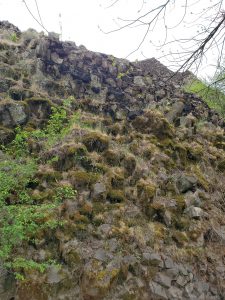

Robbie Johnson, Idaho Department of Lands Public Information Officer
(208) 908-1786 – pio@idl.idaho.gov
Negotiated Rulemaking for Easements Across Navigable Waterways
(Boise, Idaho) Idaho Department of Lands (IDL) is conducting negotiated rulemaking for IDAPA 20.03.09 – Easements on State-Owned Submerged Lands and Formerly Submerged Lands
The rulemaking will be conducted in accordance with the Governor’s Executive Order 2020-01, Zero-Based Regulation.
There are 30 owned state-owned navigable rivers that stretch for 2,500 miles, 61 state-owned navigable lakes covering 183,000 acres and 118 active easements across navigable waterways. The current fee for an easement is $300. The current cost to process an application for an easement is $479, which only incudes personnel cost, not overhead expenses.
Goals of the rulemaking are to simplify language, reduce total word count and restrictive words, and adjust fees to cover the actual costs of processing applications.
The following public meetings have been scheduled and the public may join in person, by telephone or by Zoom web conference.
Wednesday, April 28, 2021
10 a.m. (MT)
Idaho Department of Lands
Garnet Conference Rooms
300 N.6th Street, Suite 103
Boise, ID 83702
Wednesday, May 5, 2021
10 a.m. (MT)
Idaho Department of Lands
Garnet Conference Rooms
300 N.6th Street, Suite 103
Boise, ID 83702
For more information about these or any additional meetings that may be scheduled, visit the IDL website at: https://www.idl.idaho.gov/rulemaking/docket-20-0309-2101.
Written comments may be submitted to rulemaking@idl.idaho.gov or by mail to IDAPA 20.03.09, Idaho Department of Lands, P.O. Box 83720, Boise, ID 83720.
# # #
Media Contact: Sharla Arledge | PIO | 208-334-0286 | pio@idl.idaho.gov
East Fork of Rock Creek in Power County at Risk of Closing to Recreational Use
(Jerome, Idaho) Help is needed from the public. A piece of Idaho endowment trust land referred to locally as Rock Creek, is at risk of being closed due to abuse of the land. This is a popular area for camping, fishing and ATV use. Its popularity has brought several problems including trash, human waste, and destruction of land.
This year there will no longer be trash or restroom services provided to the area. Another agency previously provided these services but found it to be cost prohibitive to continue, and problems continued despite those services.
Idaho Department of Lands (IDL) is asking for the public’s help to keep this land open to recreation. Those who enjoy the land need to help protect it by taking their garbage home, staying on existing trails, and not leaving human waste.
Groups that would like to adopt this land for clean-up may contact the IDL Jerome office at 208-324-2561.
This land is owned by the Public Schools Beneficiary, with revenues from grazing and other management activities helping to fund K-12 education. Recreational use is a secondary privilege allowed only if it does not cause damage or disturb management activities.
Endowment Lands are different than other types of managed land. They were given to Idaho at statehood to create a legal trust for the sole purpose of financially supporting specific beneficiaries, in this case public schools. The Idaho Constitution requires endowment lands to be managed to maximize revenue for the beneficiaries.
Dispersed camping and other recreation activities provide no revenue to the beneficiary. Money to repair damage comes out of funding for public schools and short-changes Idaho’s children.
Media Contact: Sharla Arledge | PIO | 208-334-0286 | pio@idl.idaho.gov
Negotiated Rulemaking for Forest Practices
(Boise, Idaho) Rules for harvesting timber next to fish bearing streams may soon be easier to understand and follow. Idaho Department of Lands (IDL) will hold negotiated rulemaking for the Rules Pertaining to the Idaho Forest Practices Act. Two rules are recommended for revision to simplify implementation and to account for updated forest management technologies. Rulemaking allows forestland owners, industry, and other members of the public to participate.
The rulemaking will be conducted in accordance with the Governor’s Executive Order 2020-01, Zero-Based Regulation. Unnecessary rule language is proposed for removal, specific rule language is recommended to reduce verbiage and improve readability.
The current Shade Rule went into effect in 2014 and was established to protect the shading of fish bearing streams when timber is harvested. A study on the effectiveness of the rule was completed last year and showed the desired shade levels were being achieved. However, the rule is considered by many to be too complicated with numerous opportunities for error.
The Idaho Forest Practices Advisory Committee (FPAC) recommended language refining the definition of class one streams and simplifying the rule to promote rule understanding, make compliance easier and less costly, while maintaining the effectiveness of the rule. At this point, the rule verbiage has gone from about 492 words to 100.
FPAC also identified a need to update rules specific to the use of ground-based equipment on steep slopes. Technology used in the industry has changed; machinery is now being used on steep slopes while tethered to an anchor with a specialized winch to improve traction. This traction-assistance allows the machine to operate safely on steep slopes while minimizing soil disturbance. Existing rule language does not allow for universal use of this new family of machines; modified rule language is needed to accommodate changing technology.
The rules will now go through a negotiated process with additional input. The following public meetings have been scheduled and the public may join in person, by telephone or by Zoom web conference.
Wednesday, April 14, 2021
6 – 8 p.m. (PT)
Best Western Plus
477326 Highway 95
Ponderay, ID 83852
Thursday, April 22, 2021
6 – 8 p.m. (PT)
Best Western Plus
506 W Appleway Avenue
Coeur d’Alene, ID 83814
Thursday, April 29, 2021
6 – 8 p.m. (PT)
Best Western Lodge at River’s Edge
615 Main Street
Orofino, ID 83544
Tuesday, May 4, 2021
6 – 8 p.m. (MT)
Holiday Inn Express & Suites
210 N 3rd Street
McCall, ID 83638
For more information about these or additional meetings that may be scheduled, visit the IDL website at: https://www.idl.idaho.gov/rulemaking/docket-20-0201-2101.
IDL administers the Idaho Forest Practices Act (Title 38, Chapter 13, Idaho Code), which sets standards for logging, road building, reforestation, streamside protection, and other forest activities. The Rules Pertaining to the Idaho Forest Practices Act set minimum standards to assure the continuous growing and harvesting of forest tree species and to protect and maintain the forest soil, water resources, wildlife, and aquatic habitat.
The Idaho Forest Practices Advisory Committee (FPAC) provides technical assistance to the IDL and the Land Board in matters relating to the Idaho Forest Practices Act and its rules. FPAC is made up of nine voting members from across the state representing family forest owners, industrial forest owners, logging operators, general forest practitioners, and fisheries biology. There are also ex officio members from other state agencies and technical specialties.
# # #
Media Contact: Sharla Arledge | PIO | 208-334-0286 | pio@idl.idaho.gov
Contact: Gary Hess | Regulatory & Stewardship Program Manager |(208) 666-8636 | ghess@idl.idaho.gov
Come spring, bark beetles may attack trees damaged in winter storms
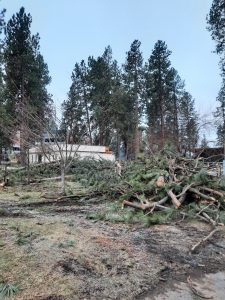
(COEUR D’ALENE) – Damaging winter storms across northern Idaho this season mean forested areas are more susceptible to infestations of certain bark beetles this spring. Photo by JD Reeves.
Idaho Department of Lands (IDL) forest health officials want forest landowners to know that trees uprooted or broken during storms can become infested by bark beetles as the weather warms. The beetles can build up populations in fresh, damaged logs and then attack and kill neighboring healthy trees. However, taking certain steps can minimize the damage.
The risk of bark beetle attack and the recommended management actions differ depending on which tree species has been damaged. The size of damaged trees also impacts their susceptibility to bark beetles. Dead trees are not at risk for infestation, only green trees and logs damaged within the past winter are cause for concern.
Pines and pine slash larger than three inches in diameter can be infested by the pine engraver beetle (Ips beetles). Pine engraver beetles infest wind-thrown trees and slash in April and May, laying eggs that develop into adults and emerge in June of the same year. Beetles that emerge in June often attack adjacent live pines.
Douglas-fir, particularly large-diameter logs, can be infested by Douglas-fir beetle. Beetles infesting damaged Douglas-fir in the spring will produce offspring that take a year to develop, emerging to attack additional Douglas-fir trees in the spring of 2022. Down, large-diameter western larch are also susceptible to attack by Douglas-fir beetle, but live, standing larch are rarely attacked.
Engelmann spruce can be infested by spruce beetle, especially if logs are large-diameter. Spruce beetles take one or more years to develop, depending on temperature, before emerging to attack additional standing spruce trees. Spruce beetles can attack ornamental species like Norway or blue spruce, but these are infrequent hosts.
These bark beetle species are highly attracted to the moist tissue under the bark of wind-thrown trees, broken tops, and logs.
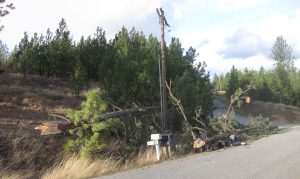 The best option to reduce beetle infestations is to remove damaged trees. If there are not enough trees to economically salvage, consider safely burning or chipping, or removing branches and cutting green logs into smaller pieces. If chipping in spring, do not pile chips near the base of standing trees since their odors can be attractive to bark beetles for a short period of time. Spread chips out in the sun, or chip in late summer or fall if possible.
The best option to reduce beetle infestations is to remove damaged trees. If there are not enough trees to economically salvage, consider safely burning or chipping, or removing branches and cutting green logs into smaller pieces. If chipping in spring, do not pile chips near the base of standing trees since their odors can be attractive to bark beetles for a short period of time. Spread chips out in the sun, or chip in late summer or fall if possible.
Forest owners can hasten the drying of logs and green wood by spreading them in a sunny area before beetles fly in the spring. Leaving damaged trees or decks of green logs in shady areas increases the chances that they will be infested. DO NOT stack green firewood next to live standing trees. The idea is to reduce the number of places for the damaging beetles to breed and then kill live trees.
In pines, quick action is necessary since beetles can emerge from damaged pine materials as early as June, 2021. Large-diameter logs of Douglas-fir, western larch, and spruce will not pose a threat until spring, 2022. These logs can be bucked and split this spring or summer and left to dry out and kill any developing beetles before they emerge next spring. Infested materials can also be removed, chipped, or burned during the winter of 2021-2022.
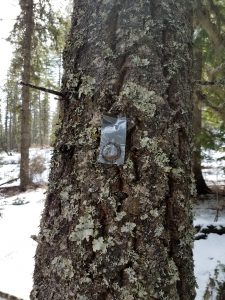 Pheromone repellent pouches called MCH are an additional tool to ward off Douglas-fir beetle. These pouches can be stapled to susceptible down logs in April, 2021, and will prevent infestation by Douglas-fir beetle by tricking beetles into thinking the logs have already been fully attacked. If down logs cannot be treated this April and become infested, surrounding stands can be protected with MCH applied to nearby standing trees in April, 2022. MCH is very effective at protecting Douglas-fir trees, but it will not work to protect pines and has limited effectiveness in protecting spruce. For additional information about using pheromones, please contact the IDL forest health team at (208) 769-1525.
Pheromone repellent pouches called MCH are an additional tool to ward off Douglas-fir beetle. These pouches can be stapled to susceptible down logs in April, 2021, and will prevent infestation by Douglas-fir beetle by tricking beetles into thinking the logs have already been fully attacked. If down logs cannot be treated this April and become infested, surrounding stands can be protected with MCH applied to nearby standing trees in April, 2022. MCH is very effective at protecting Douglas-fir trees, but it will not work to protect pines and has limited effectiveness in protecting spruce. For additional information about using pheromones, please contact the IDL forest health team at (208) 769-1525.
More information on Idaho forest health is available here. IDL Private Forestry Specialists also are available in offices across the region to assist forest landowners. Information about landowner assistance is available here.
Additional FAQs
What are bark beetles? Bark beetles are a group of insects that spend almost their entire life beneath the bark of trees. They tunnel in the moist inner bark, lay eggs and these develop into larvae or grubs. The tunneling kills trees by girdling them (cuts off the supply of nutrients). Adults emerge later to infest other trees in late spring or early summer. For more information, please see the IDL bark beetle fact sheet.
Certain bark beetles can reproduce in green logs, uprooted trees and green firewood if the inner bark is moist in April and May.
Bark beetles are cold blooded, so they will develop faster during warm weather. Drought and hot, dry summers are stressful for trees and increase the success of bark beetles.
What species cause the most problems?
Pine engraver prefers damaged ponderosa and lodgepole pine trees and slash. It has multiple generations per year. Pine engraver overwinters as an adult, and flies early in the spring as temperatures warm. It infests green pine logs > 3” diameter in April and May and lays eggs. These eggs develop into adults approximately 6 weeks later. The emerging adults will infest more down material if it is available; if none is available they will attack standing trees in July. Normally, the eggs laid in these standing trees develop into adults that overwinter. Dead trees can occur in summer, 2021. For more information, please see the IDL pine engraver fact sheet.
Douglas-fir beetle can infest damaged Douglas-fir or down western larch. This species has one generation per year. It overwinters as an adult, and flies early in the spring and prefers green, down material. Beetles tunnel in the bark, lay eggs and one generation of larvae develop in the logs or down trees. Adults then overwinter under the bark or in the forest litter. Dead trees can occur in 2022. For more information, please see the IDL Douglas-fir beetle fact sheet.
Spruce beetle can attack damaged spruce and takes one or two years to develop in infested logs, depending on temperature. Spruce beetle outbreaks can be very severe if many host trees are present. Dead trees can occur in 2022, but needles on fatally-attacked trees may remain green for longer.
What is the best way to avoid problems? The best course of action is to NOT have down, green material available in spring when the bark beetles emerge. If logs become infested, remove or destroy them before beetles can emerge.
Forest Landowners: If there are enough damaged trees to economically salvage, that is the best option.
What if I am a landowner in an urban or suburban area? Some counties or municipalities will accept woody material at transfer stations or landfills. The material is often chipped to be used for other purposes such as mulch or industrial fuel.
If you can’t remove the damaged trees or slash, try to make them unsuitable for bark beetle reproduction. If salvage is not practical, damaged trees can be safely burned if allowed, debarked or chipped. Planer chainsaw attachments, such as the LogWizard, can be effective tools for bark removal. If this is not practical, broken tops or uprooted trees can be cut into smaller pieces and the limbs removed. Placing them in sunny areas will assist the drying process. The idea is to help the logs to dry out as quickly as possible.
Can I save the wood for use as firewood? If the species is not pine, firewood cut into 16” pieces and split may be infested by beetles this spring, but it is unlikely that any beetles will emerge in 2022. This is not the best option for pine because beetles will infest the wood and emerge around June, 2021. Never stack green firewood next to live standing trees. This is inviting bark beetles to kill the standing trees when they emerge.
Decks of green logs stored through the winter are very likely to become infested in the spring if the inner bark is still moist. Snow cover and shade will increase the drying time.
Media Contact
Erika Eidson
Forest Health Specialist
Idaho Department of Lands
3284 W. Industrial Loop
Coeur d’Alene, ID 83815
Office (208) 769-1525
Desk (208) 666-8625

